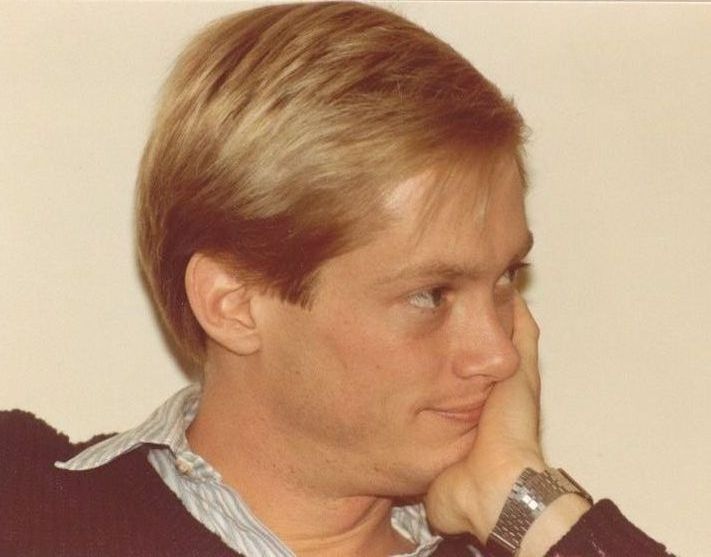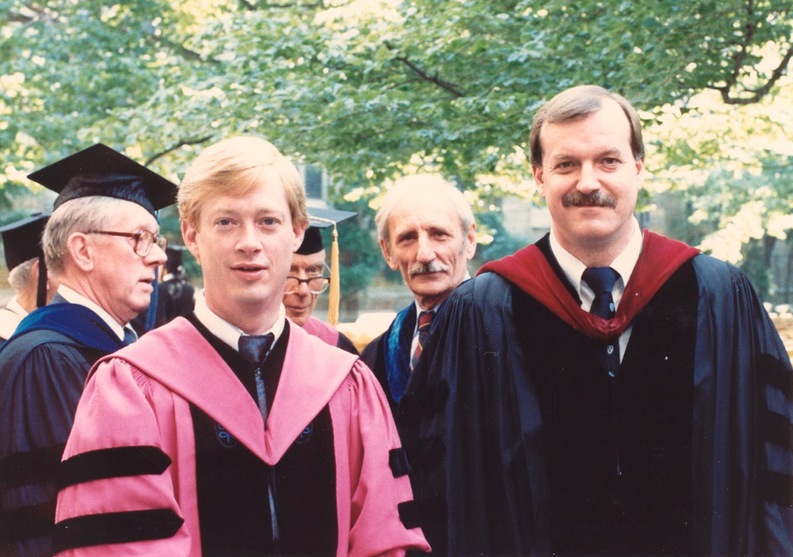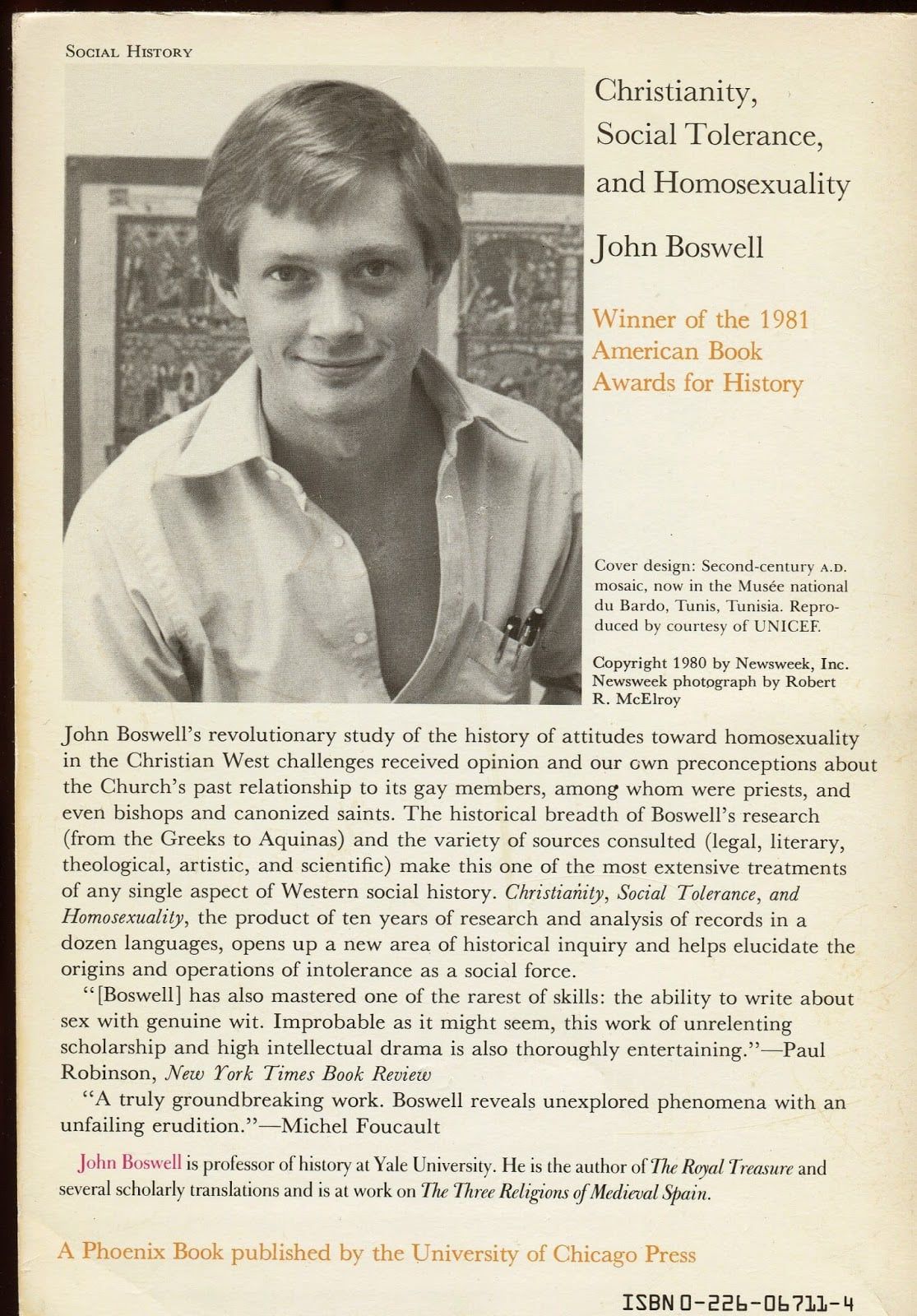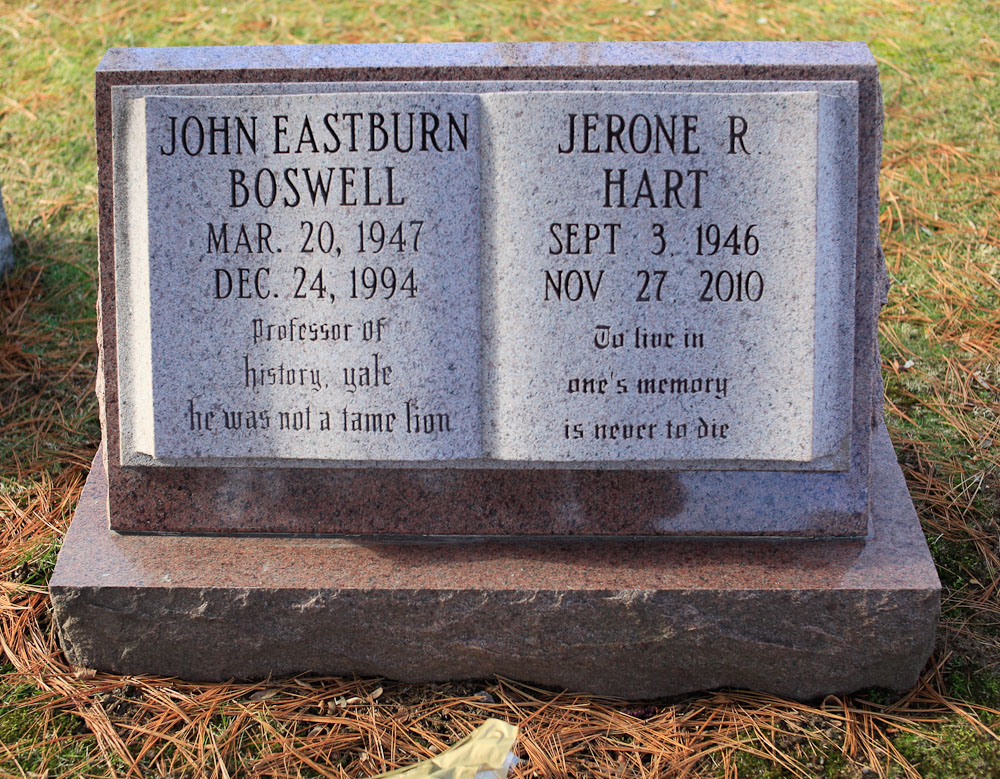Obituary by David W Dunlap, NY Times. Published: December 25, 1994
John Eastburn Boswell, a Yale University historian who upended medieval scholarship by finding not only that homosexuality was tolerated in the Middle Ages but that same-sex unions were celebrated liturgically, died yesterday in the Yale infirmary. He was 47 and lived in New Haven. The cause was complications from AIDS.
"I regard him as one of the major innovative figures in gay and lesbian scholarship," said Martin Duberman, founder and executive director of the Center for Lesbian and Gay Studies at the City University of New York. "John was very brave and pioneering. And very brilliant."
He was also controversial. Some scholars and theologians disputed his findings, which gained wide notice in 1980 with the publication of "Christianity, Social Tolerance, and Homosexuality: Gay People in Western Europe From the Beginning of the Christian Era to the Fourteenth Century" (University of Chicago Press).
"I would not hesitate to call his book revolutionary," Paul Robinson, a Stanford University historian, wrote in The New York Times Book Review, "for it tells of things heretofore unimagined and sets a standard of excellence that one would have thought impossible in the treatment of an issue so large, uncharted and vexed." It won the American Book Award for history in 1981.
One major aim of his work, Dr. Boswell wrote, was "to rebut the common idea that religious belief -- Christian or other -- has been the cause of intolerance in regard to gay people."
Among his findings was that there had been, from about 1050 to 1150, "an efflorescence of gay subculture, with a highly developed literature, its own argot and artistic conventions, its own low life, its elaborate responses to critics."
Last June, Dr. Boswell again captured attention -- and provoked much debate -- with "Same-Sex Unions in Premodern Europe" (Villard Books), based on the study of more than 60 manuscripts from the 8th to the 16th century.
By the 12th century, Dr. Boswell wrote, the ceremony of same-sex union had become a "full office" which involved burning candles, placing the parties' hands on the Gospel, binding their hands or covering their heads with the priest's stole, saying the Lord's Prayer, receiving communion, kissing and sometimes circling the altar.
As to whether the ceremony celebrated a "relationship between two men or two women that was (or became) sexual," Dr. Boswell wrote, "Probably, sometimes, but this is obviously a difficult question to answer about the past, since participants cannot be interrogated."
He was far more confident in declaring that the ceremony was "unmistakably a voluntary, emotional union of two persons," one that was "closely related" to heterosexual marriage, "no matter how much some readers may be discomforted by this."
James Brundage, a professor of history and law at the University of Kansas, said in an interview last summer that "the mainstream reaction was that he raised some interesting questions, but hadn't proved his case."
And Brent D. Shaw, of the University of Lethbridge in Alberta, argued in The New Republic that the ceremonies Dr. Boswell described were more akin to the "ritualized agreements struck between members of the Mafia or other 'men of honor' in our own society."
Scholars were not the only ones wrestling with this matter. At least two newspapers withheld the comic strip "Doonesbury," by Garry Trudeau, in which the character Mark Slackmeyer described the "gay marriages" uncovered by Dr. Boswell: "They were just like heterosexual ceremonies, except that straight weddings, being about property, were usually held outdoors. Gay rites, being about love, were held inside the church!"
Dr. Boswell's other major work was "The Kindness of Strangers: The Abandonment of Children in Western Europe From Late Antiquity to the Renaissance" (Pantheon Books), published in 1989.
"Marred though it may be by interpretive excesses, this is a pioneering work of large importance," Mary Martin McLaughlin, a historian, wrote in The New York Times Book Review. She added that it was "the first to map out and explore a tangled, mysterious region of human experience."
Dr. Boswell was born in Boston. He attended the College of William and Mary and Harvard University, from which he received his master's degree and doctorate. Among the 17 languages he read or spoke, Dr. Boswell counted Church Slavonic, Old Icelandic and some classical Armenian, Syriac and Persian.
He joined the Yale faculty in 1975 as an assistant professor, was appointed a full professor in 1982 and named the A. Whitney Griswold Professor of History in 1990, when he began a two-year term as chairman of the history department.
In 1987, Dr. Boswell helped organize the Lesbian and Gay Studies Center at Yale, which is now the Research Fund for Lesbian and Gay Studies.
He is survived by his parents, Col. Henry Boswell Jr. and Catharine, of Grand Junction, Colo.; a sister, Patricia, of Greensboro, N.C. and two brothers, Wray, of Virginia Beach, Va., and Henry 3d, of Chapel Hill, N.C. and his life partner of many years Jerone Hart
________________________________________
Dignity Convention 1979 Keynote Address
Facebook Memorial
Obituary by David W Dunlap, NY Times. Published: December 25, 1994
John Eastburn Boswell, a Yale University historian who upended medieval scholarship by finding not only that homosexuality was tolerated in the Middle Ages but that same-sex unions were celebrated liturgically, died yesterday in the Yale infirmary. He was 47 and lived in New Haven. The cause was complications from AIDS.
"I regard him as one of the major innovative figures in gay and lesbian scholarship," said Martin Duberman, founder and executive director of the Center for Lesbian and Gay Studies at the City University of New York. "John was very brave and pioneering. And very brilliant."
He was also controversial. Some scholars and theologians disputed his findings, which gained wide notice in 1980 with the publication of "Christianity, Social Tolerance, and Homosexuality: Gay People in Western Europe From the Beginning of the Christian Era to the Fourteenth Century" (University of Chicago Press).
"I would not hesitate to call his book revolutionary," Paul Robinson, a Stanford University historian, wrote in The New York Times Book Review, "for it tells of things heretofore unimagined and sets a standard of excellence that one would have thought impossible in the treatment of an issue so large, uncharted and vexed." It won the American Book Award for history in 1981.
One major aim of his work, Dr. Boswell wrote, was "to rebut the common idea that religious belief -- Christian or other -- has been the cause of intolerance in regard to gay people."
Among his findings was that there had been, from about 1050 to 1150, "an efflorescence of gay subculture, with a highly developed literature, its own argot and artistic conventions, its own low life, its elaborate responses to critics."
Last June, Dr. Boswell again captured attention -- and provoked much debate -- with "Same-Sex Unions in Premodern Europe" (Villard Books), based on the study of more than 60 manuscripts from the 8th to the 16th century.
By the 12th century, Dr. Boswell wrote, the ceremony of same-sex union had become a "full office" which involved burning candles, placing the parties' hands on the Gospel, binding their hands or covering their heads with the priest's stole, saying the Lord's Prayer, receiving communion, kissing and sometimes circling the altar.
As to whether the ceremony celebrated a "relationship between two men or two women that was (or became) sexual," Dr. Boswell wrote, "Probably, sometimes, but this is obviously a difficult question to answer about the past, since participants cannot be interrogated."
He was far more confident in declaring that the ceremony was "unmistakably a voluntary, emotional union of two persons," one that was "closely related" to heterosexual marriage, "no matter how much some readers may be discomforted by this."
James Brundage, a professor of history and law at the University of Kansas, said in an interview last summer that "the mainstream reaction was that he raised some interesting questions, but hadn't proved his case."
And Brent D. Shaw, of the University of Lethbridge in Alberta, argued in The New Republic that the ceremonies Dr. Boswell described were more akin to the "ritualized agreements struck between members of the Mafia or other 'men of honor' in our own society."
Scholars were not the only ones wrestling with this matter. At least two newspapers withheld the comic strip "Doonesbury," by Garry Trudeau, in which the character Mark Slackmeyer described the "gay marriages" uncovered by Dr. Boswell: "They were just like heterosexual ceremonies, except that straight weddings, being about property, were usually held outdoors. Gay rites, being about love, were held inside the church!"
Dr. Boswell's other major work was "The Kindness of Strangers: The Abandonment of Children in Western Europe From Late Antiquity to the Renaissance" (Pantheon Books), published in 1989.
"Marred though it may be by interpretive excesses, this is a pioneering work of large importance," Mary Martin McLaughlin, a historian, wrote in The New York Times Book Review. She added that it was "the first to map out and explore a tangled, mysterious region of human experience."
Dr. Boswell was born in Boston. He attended the College of William and Mary and Harvard University, from which he received his master's degree and doctorate. Among the 17 languages he read or spoke, Dr. Boswell counted Church Slavonic, Old Icelandic and some classical Armenian, Syriac and Persian.
He joined the Yale faculty in 1975 as an assistant professor, was appointed a full professor in 1982 and named the A. Whitney Griswold Professor of History in 1990, when he began a two-year term as chairman of the history department.
In 1987, Dr. Boswell helped organize the Lesbian and Gay Studies Center at Yale, which is now the Research Fund for Lesbian and Gay Studies.
He is survived by his parents, Col. Henry Boswell Jr. and Catharine, of Grand Junction, Colo.; a sister, Patricia, of Greensboro, N.C. and two brothers, Wray, of Virginia Beach, Va., and Henry 3d, of Chapel Hill, N.C. and his life partner of many years Jerone Hart
________________________________________
Dignity Convention 1979 Keynote Address
Facebook Memorial












